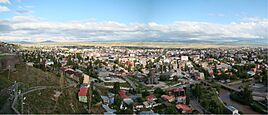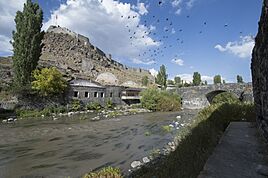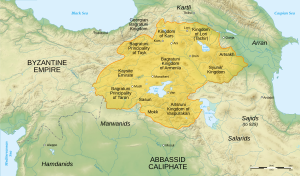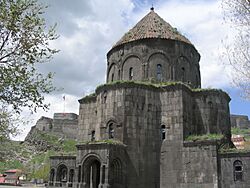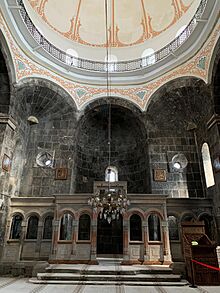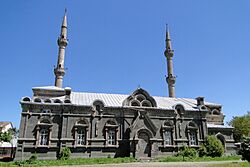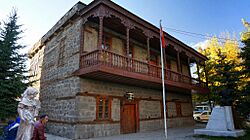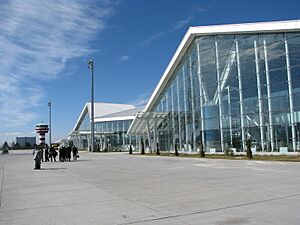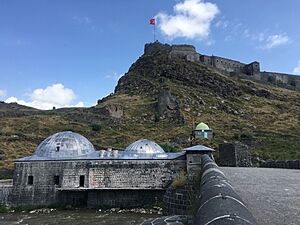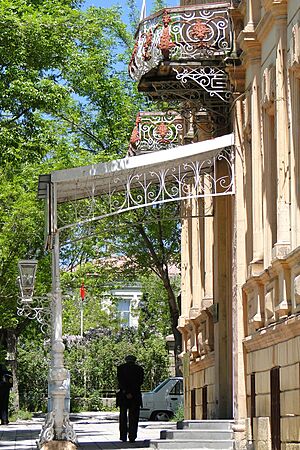Kars facts for kids
Quick facts for kids
Kars
Կարս
Qers |
|
|---|---|
|
Clockwise from top: View of Kars city centre, Castle of Kars, Panoramic view of Kars Topçuoğlu Hamam and Taşköprü, Cathedral of Kars
|
|
| Country | Turkey |
| Province | Kars |
| District | Kars |
| Elevation | 1,768 m (5,801 ft) |
| Population
(2022)
|
91,450 |
| Time zone | TRT (UTC+3) |
| Postal code |
36000
|
| Area code | 0474 |
Kars is a city located in northeast Turkey. It is the main city of Kars Province and Kars District. In 2022, about 91,450 people lived there. Kars has a very long history. It was once part of an ancient region called Chorzene. It was also a capital city for the Bagratid Kingdom of Armenia from 929 to 961. Today, the mayor of Kars is Türker Öksüz.
Contents
What's in a Name?
The name of the city, Kars, might come from the Armenian word hars, which means 'bride'. Another idea is that it comes from the Georgian word kari, meaning 'gate'.
Exploring Kars' Past
Medieval Times in Kars
Not much is known about the very early days of Kars. We do know that in medieval times, Kars had its own Armenian rulers. It was the capital of a region called Vanand. Armenian historians used different names for the city, like 'Kars city' or 'Kars Fortress'.
Around the 800s, Kars became part of the Armenian Bagratuni kingdom. From 929 to 961, Kars was the capital of this kingdom. During this time, an important church, later known as the Church of the Holy Apostles, was built.
In 963, Kars became the capital of a separate kingdom, also called Vanand. This happened after the Bagratuni rulers moved their main city to Ani. In 1064, after the Seljuk Turks captured Ani, the Armenian king of Kars, Gagik-Abas, made peace with the Turks. He gave his kingdom to the Byzantine Empire in 1065, but the Seljuk Turks soon took Kars.
After the Seljuks, Kars became a small emirate (a state ruled by an emir). In 1206, the Zakarids–Mkhargrdzeli captured Kars. Then, in 1242, the Mongols took control. Later, Kars was influenced by Georgia.
Over the centuries, Kars was ruled by different groups, including the Jalayirids, Qara Qoyunlu, and Aq Qoyunlu. In 1387, the city was destroyed by Timur (also known as Tamerlane).
Later, Kars became part of the Safavid dynasty of Iran. In 1555, after a war, Kars was declared neutral, and its fortress was destroyed. However, in 1585, the Ottomans took the city. The Safavid ruler Abbas I took it back in 1604. The Ottomans rebuilt the city's defenses, which helped it survive a siege by Nader Shah of Persia in 1731.
Kars Under Russian Rule
In 1807, Kars successfully defended itself against an attack by the Russian Empire. However, in 1828, the city surrendered to Russian forces after another siege. After that war, Kars was given back to Ottoman control.
During the Crimean War, in 1855, an Ottoman army with British officers defended Kars against the Russians. But after a long siege, with many soldiers getting sick and food running out, the city surrendered in November 1855.
Kars became even more important as the Ottoman and Russian empires fought over it. In the Russo-Turkish War, 1877–78, Russian forces stormed the fortress. After this war, Kars was given to Russia by the Treaty of San Stefano. Kars then became the capital of the Kars Oblast (a large region). The Russians made the defenses of Kars stronger.
Between 1878 and 1881, many Muslims moved from Kars to the Ottoman Empire. At the same time, many Armenians and Pontic Greeks moved to Kars from other areas. By 1897, the population of Kars was about 49.7% Armenian, 26.3% Russian, and 11.7% Caucasus Greek.
Kars During World War I
In the First World War, Kars was a key target for the Ottoman army. In March 1918, Russia gave Kars to the Ottoman Empire. However, Armenian and non-Bolshevik Russian forces controlled Kars at that time. The Ottoman Empire captured Kars in April 1918.
After the war, Kars came under the control of the First Republic of Armenia. But the Ottomans did not want to give up Kars. A pro-Turkish government was set up in the city. In April 1919, British and Armenian troops ended this government. By May 1919, Kars was fully controlled by the Armenian Republic.
In the autumn of 1920, Turkish forces invaded the Armenian Republic. Kars, despite its strong defenses, was taken by Turkish forces on October 30, 1920. This was a big defeat for Armenia. The Treaty of Alexandropol forced Armenia to give up territories.
Later, the Treaty of Kars was signed in October 1921 between Turkey and the Soviet Union. This treaty set the current borders between Turkey and the Soviet republics of Armenia, Azerbaijan, and Georgia.
Kars After World War II
After World War II, the Soviet Union wanted to take back the Kars region and Ardahan. In June 1945, the Soviet Foreign Minister told Turkey that these regions should be returned. Turkey was in a tough spot. It wanted good relations with the Soviet Union but did not want to give up land.
The United States, seeing Turkey as an ally against the Soviet Union during the Cold War, started to support Turkey. By 1948, the Soviet Union stopped its claims on Kars and the other regions.
Kars Today
In April 1993, Turkey closed its border crossing with Armenia near Kars. This was a protest against Armenian forces capturing a district in Azerbaijan. Since then, the land border between Armenia and Turkey has stayed closed.
Some people in Kars believe that opening the border would help the local economy. However, there has been opposition from the local population and pressure from Azerbaijan to keep the border closed. As of 2014, the border remains closed.
The last elected mayor of Kars was Ayhan Bilgen. He was elected in 2019 but was later removed from office in 2020. A government-appointed trustee took his place.
Who Lives in Kars?
According to Turkey's 2011 statistics, many people have moved from Kars to bigger cities. For example, over 269,000 people from Kars live in Istanbul alone. This is more than three times the population of Kars itself.
Today, Kars has a mix of people, including Azerbaijanis, Kurds, and Turks. The Azerbaijanis mainly belong to the Terekeme and Qarapapaq groups. About 20% of the city's population are Shia Azerbaijanis.
Most people in Kars are Sunni Muslim, mainly Kurds and Turks. A smaller group are Shia Muslim, mostly among the Azerbaijanis.
| Year | Total | Turks | Armenians | Others |
|---|---|---|---|---|
| 1878 | 4,244 | 2,835 (66.8%) | 1,031 (24.4%) | 378 Caucasus Greeks (8.9%) |
| 1886 | 3,939 | 841 (21.4%) | 2,483 (63%) | 322 Caucasus Greeks (8.2%), 247 Russians (6.3%) |
| 1897 | 20,805 | 786 (3.8%) | 10,332 (49.7%) | 5,478 Russians (26.3%), 1,084 Poles (5.2%), 733 Caucasus Greeks (3.5%), 486 Tatars (2.3%) |
| 1916 | 30,514 | 1,210 (3.9%) | 25,665 (84.1%) | 1,487 Russians (4.9%), 1,828 other Christians (5.9%), 298 other Muslims, 25 Jews |
| 1970 | 54,000 | |||
| 1990 | 78,455 | |||
| 2000 | 78,473 | |||
| 2013 | 78,101 |
Kars' Weather
Kars has a humid continental climate. This means it has big changes in temperature between seasons and even during the day. This is because it's far from large bodies of water and is at a high elevation.
Summers are usually short and quite warm, but nights are cool. The average high temperature in August is about 27°C (81°F).
Winters are very cold. The average low temperature in January is about -15°C (5°F). Temperatures can drop to -30°C (-22°F) in winter. Kars gets a lot of snow, with snow covering the ground for about four months each year.
The highest temperature ever recorded in Kars was 37.1°C (98.8°F) on August 24, 2022. The lowest was -37.0°C (-34.6°F) on February 4, 1947.
| Climate data for Kars (1991–2020, extremes 1931–2023) | |||||||||||||
|---|---|---|---|---|---|---|---|---|---|---|---|---|---|
| Month | Jan | Feb | Mar | Apr | May | Jun | Jul | Aug | Sep | Oct | Nov | Dec | Year |
| Record high °C (°F) | 9.3 (48.7) |
12.0 (53.6) |
19.1 (66.4) |
25.0 (77.0) |
28.3 (82.9) |
33.9 (93.0) |
35.6 (96.1) |
37.1 (98.8) |
33.0 (91.4) |
26.8 (80.2) |
21.9 (71.4) |
15.9 (60.6) |
37.1 (98.8) |
| Mean daily maximum °C (°F) | −3.2 (26.2) |
−1.2 (29.8) |
4.9 (40.8) |
12.3 (54.1) |
17.3 (63.1) |
22.2 (72.0) |
26.3 (79.3) |
27.3 (81.1) |
23.0 (73.4) |
16.1 (61.0) |
7.5 (45.5) |
−0.4 (31.3) |
12.7 (54.9) |
| Daily mean °C (°F) | −9.4 (15.1) |
−7.7 (18.1) |
−1.0 (30.2) |
5.7 (42.3) |
10.4 (50.7) |
14.5 (58.1) |
17.9 (64.2) |
18.4 (65.1) |
14.1 (57.4) |
8.2 (46.8) |
0.6 (33.1) |
−6.2 (20.8) |
5.5 (41.9) |
| Mean daily minimum °C (°F) | −14.8 (5.4) |
−13.4 (7.9) |
−6.3 (20.7) |
−0.2 (31.6) |
4.3 (39.7) |
7.4 (45.3) |
10.5 (50.9) |
10.7 (51.3) |
6.1 (43.0) |
1.5 (34.7) |
−4.8 (23.4) |
−11.2 (11.8) |
−0.8 (30.6) |
| Record low °C (°F) | −36.7 (−34.1) |
−37.0 (−34.6) |
−31.5 (−24.7) |
−22.6 (−8.7) |
−7.0 (19.4) |
−4.0 (24.8) |
0.1 (32.2) |
−1.9 (28.6) |
−4.4 (24.1) |
−17.5 (0.5) |
−30.0 (−22.0) |
−35.0 (−31.0) |
−37.0 (−34.6) |
| Average precipitation mm (inches) | 23.2 (0.91) |
21.4 (0.84) |
33.1 (1.30) |
57.0 (2.24) |
83.6 (3.29) |
75.0 (2.95) |
65.1 (2.56) |
45.1 (1.78) |
29.7 (1.17) |
44.6 (1.76) |
26.6 (1.05) |
25.6 (1.01) |
530.0 (20.87) |
| Average precipitation days | 9.97 | 9.6 | 11.23 | 13.9 | 18.93 | 14.37 | 11.13 | 9.67 | 7.07 | 10.17 | 8.43 | 10.43 | 134.9 |
| Average relative humidity (%) | 78.9 | 77.6 | 73.5 | 67.3 | 67.3 | 65.3 | 64.3 | 60.1 | 59.8 | 67.8 | 73.1 | 78.9 | 69.5 |
| Mean monthly sunshine hours | 105.4 | 132.8 | 167.4 | 183.0 | 226.3 | 276.0 | 316.2 | 310.0 | 249.0 | 192.2 | 147.0 | 102.3 | 2,407.6 |
| Mean daily sunshine hours | 3.4 | 4.7 | 5.4 | 6.1 | 7.3 | 9.2 | 10.2 | 10.0 | 8.3 | 6.2 | 4.9 | 3.3 | 6.5 |
| Source 1: Turkish State Meteorological Service | |||||||||||||
| Source 2: NOAA(humidity) | |||||||||||||
Sports in Kars
Kars has a football club called Kars S.K. In the past, a sport called Bandy was played here, even though it's not played in Turkey today.
Learning in Kars
Kars is home to Kafkas University, which was started in 1992.
Getting Around Kars
Kars is connected by a main highway from Erzurum. Smaller roads go north to Ardahan and south to Igdir. The city has an airport, Kars Harakani Airport, with daily flights to Ankara and Istanbul.
Kars also has a train station on the Turkish Railways (TCDD). This line connects Kars to Erzurum. The train link to Armenia has been closed since April 1993. This happened after Armenian forces occupied a district in Azerbaijan. Turkey says the border will stay closed until this occupation ends.
A new railway line, the Kars–Tbilisi–Baku railway, started being built in 2010. It connects Turkey with Georgia and Azerbaijan. This line began working on October 30, 2017. It links Kars to Akhalkalaki in Georgia, and from there, trains go to Tbilisi and Baku.
Famous Places to See
Kars Citadel: A Historic Fortress
The Castle of Kars (also known as the Citadel) sits on top of a rocky hill, looking over the city. Parts of its walls are from the ancient Bagratuni Armenian period. But it likely got its current shape in the 1200s when the Zak'arid dynasty ruled Kars.
You can see crosses on the walls in several places. One has a Khachkar (an Armenian carved cross-stone) with Armenian writing. This shows that the castle was not built by the Ottoman Sultan Murad III in the 1500s, as some stories say. However, Murad probably did order many of the city walls to be rebuilt.
By the 1800s, the citadel was not as important for defense. New fortresses were built around Kars. These new defenses were very important during the Siege of Kars in 1855.
Other Old Buildings in Kars
Below the castle is a mosque that used to be an Armenian church called Surb Arak'elots, or the Church of the Holy Apostles. It was built in the 930s. Outside, it has carvings of twelve figures, thought to be the Twelve Apostles. The church became a mosque in 1579. Then, in the 1880s, it became a Russian Orthodox church. The Russians added porches and a clocktower (which is now gone). The building was used as a warehouse in the 1930s and a small museum from 1963 to the late 1970s. In 1993, it was changed back into a mosque. There are also two other ruined Armenian churches nearby. A Russian church from the 1900s was also turned into a mosque in the 1980s.
The Grand Mosque of Kars is the biggest old mosque in the city. It was built by the Seljuks and fixed up by the Ottomans in 1579.
The Taşköprü (Stone Bridge) was built over the Kars River in 1725. Near the bridge are three old bath-houses, but they are not used anymore.
Kars has buildings with many different styles because it has been a meeting point for Turkish, Armenian, Georgian, Kurdish, and Russian cultures. Many buildings from the Russian era look like those in Gyumri, Armenia. The author Orhan Pamuk wrote about the "Russian houses" in Kars in his novel Snow. He said they were built in a "Baltic style" and were unique in Turkey.
Some other interesting places include:
- The Mansion of Ahmet Tevfik Pasha
- The Topchuoglu Bath House
- The Ilbeoglu Bath House
- The Mazlumaga Bath House
- The House of Namık Kemal
- Kars Museum
- The Palace of Beylerbeyi
- The Mansion of Pasha
- The Cemetery of Arap Baba
- The Mosque of Yusuf Pasha
- The Mosque of Evliya
- The Tomb of Ebul Hasan-i Harakani
- The Mosque of Fethiye
- The Mansion of Gazi Ahmet Muhtar Pasha
Images for kids
Kars' Connections with Other Cities
Kars has special "sister city" relationships with these cities:
See also
 In Spanish: Kars para niños
In Spanish: Kars para niños


